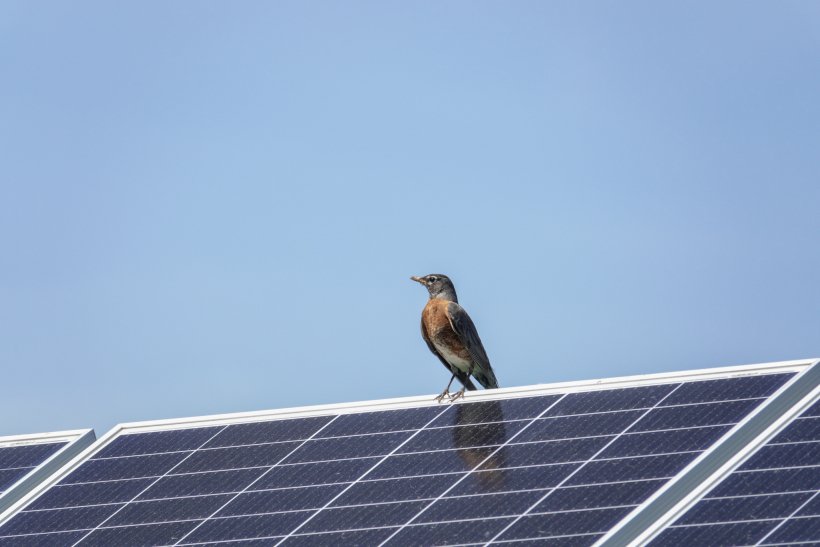Understanding how wildlife interacts with solar arrays is critical to maintaining healthy ecosystems while deploying clean energy.
A team at Argonne National Laboratory set out to develop a camera system that could continuously monitor how birds behave around solar panels using artificial intelligence. Their results provided greater understanding of bird behaviors at large-scale solar sites. Now, they’re testing this system across the country to build a bigger picture of bird interactions with solar systems to support ecologically responsible solar deployment.

Building enough solar energy to decarbonize the U.S. economy by 2035 could require as much as 5.7 million acres of land. While this is only about 0.3% of the contiguous United States, it is critical to understand how solar infrastructure impacts local wildlife so we can develop strategies and technologies that avoid or minimize adverse impacts and maximize benefits.
Early studies of solar photovoltaic (PV) facilities in the Southwest found deceased birds, leading to the hypothesis that birds are colliding with panels. However, recent studies at PV sites around the country have found that fatalities may not be as common as initially suspected, and that birds are using the sites as habitat. Research on the risk of birds colliding with PV panels has been inconclusive. The solar industry, wildlife management agencies, and conservation groups need more information on solar-avian interactions to design facilities and management practices that could prevent harm to birds, and even provide habitat.
With $1.3 million of funding from the U.S. Department of Energy Solar Energy Technologies Office (SETO), Argonne National Laboratory researchers developed and tested an innovative camera system that tracks birds as they interact with solar panels and automatically classifies their behavior using a machine learning algorithm.
Their software program uses artificial intelligence to detect a bird when it enters the camera’s field of vision and differentiate it from other moving objects, such as insects and other wildlife, plants or cables blowing in the wind, and shadows. Then, it classifies the bird’s behavior into one of six categories: flying over the panel, flying through the panels, perching on the panel, colliding with the panel, perching in the background, or landing on the ground.
The team recorded more than 17,000 hours of videos of birds interacting with solar facilities and found their system to be as high as 95% accurate in identifying bird behaviors. The system also works in real time and can quickly alert researchers and system operators of any bird behaviors of interest.
In all 17,000 hours of video, the cameras did not detect a single collision of a bird with a solar panel. The lack of collisions detected is a positive sign; however, further research is needed to evaluate the extent of avian collisions at PV sites across the United States since the cameras were deployed at a limited number of sites for this study.
The birds did interact with the panels, though–they recorded many instances of the birds perching on and flying around the panels. The birds also interacted with the panels in ways beyond what the algorithm were designed to classify. While reviewing the footage, the researchers observed the birds using the underside of the panels for activities like foraging, nesting, and roosting. These behaviors indicate that the solar panels could act as a valuable habitat for birds.
Now, the Argonne researchers are expanding on this work with $2.1 million of additional SETO funding to deploy their camera system at seven solar facilities across the country. From forested areas in the Northeast to semi-industrial areas in the desert Southwest to urban areas and rural farmland in the Midwest, these new sites will paint a more complete picture of how different bird species across different ecosystems interact with solar facilities. The team is also expanding its machine learning algorithm and camera system to automatically detect more bird behaviors.

The insights gained from this detection system will inform the development of best practices for siting, designing, and managing solar facilities in an environmentally responsible way. Scientists and conservation organizations can also use the project’s findings to assess the effects of solar deployment on bird populations and prioritize research gaps. Government agencies and community members can use these insights to make informed decisions about permitting solar energy sites and supporting bird populations.
The Argonne project is part of SETO’s larger efforts to understand how solar energy interacts with wildlife and the environment. By developing the tools and methods needed to deploy solar energy in an environmentally responsible way, SETO is ensuring that communities can reap the benefits of clean energy and maintain healthy ecosystems.
Learn more about SETO’s soft costs work to address challenges associated with non-hardware cost components of solar energy systems.









